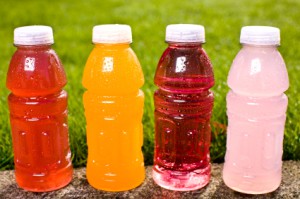Is What in You? The Effectiveness of Sports Drinks
My husband and I shared a “back in the day” moment recently while grocery shopping. We browsed the aisle of sports drinks, noting the extended variety of flavors among the top brands, and we recalled with a laugh how – twenty or more years ago – a store wouldn’t be able to devote this much space to  one product. Back in “the day,” one brand dominated the market, and you had two choices: green or orange – and it came in one size…in a glass bottle at that. It wasn’t the most pleasant tasting stuff, but during those hot summers when I played softball for the Cedar Hills Athletics Club, it did the trick to keep the team hydrated.
one product. Back in “the day,” one brand dominated the market, and you had two choices: green or orange – and it came in one size…in a glass bottle at that. It wasn’t the most pleasant tasting stuff, but during those hot summers when I played softball for the Cedar Hills Athletics Club, it did the trick to keep the team hydrated.
Now, you’ll find single bottles one can fasten to a bicycle drink holder, and a myriad of flavors, some of which don’t even describe what the drink is supposed to taste like. Names like Riptide Rush and Glacier Freeze, for example, may hint at a cooling sensation, but as you work out are drinks like these the best to have around when it’s time to hydrate?
Rule of thumb for intense exercise is to drink about six ounces for every twenty minutes. Some fitness center may even require you to have a bottle on hand as you do the circuit to ensure you’re getting something in your body – it keeps you alert and refreshed, and helps prevent fatigue and other ailments associated with dehydration. As any health expert to name the best drink for exercise, however, and you’ll definitely hear water most often. Our body is made up of water, and replacing what you lose throughout the day is the best recommendation for continued health. Making the effort to actually drink the water you need can be a chore – you become forgetful or you just can’t bring yourself to drink another drop. It makes sense, therefore, that sports drinks are popular. There is variety, and many tout electrolytes designed to expedite hydration and other nutrients to assist burning calories.
Well and good, but are sports drinks better for you?
Look at the label of your favorite soda. More than likely the main ingredient is high fructose corn syrup. HFCS, or “corn sugar,” has been in the news of late. Critics charge that consumption of HFCS can prove more detrimental than if one simply used sugar, while pundits for corn sugar argue that the sweetener is no more dangerous. Over the last decade, popular soft drink companies have replaced the cane sugar used to sweeten their products with HFCS because it is cheaper and easier to add due to its liquid state. Now, the savvy exerciser wouldn’t think to hydrate with a soft drink after a grueling run on the treadmill, but pick up a sports drink with the same ingredients, and you may as well be doing that. Check the labels: you just may find HCFS is in your drink. The disadvantage to sports drinks is that fructose can effect how quickly you hydrate; this in turn may cause you to drink more HCFS than you really need.
Will sports drinks improve performance? To watch their commercials, it may be implied that after guzzling down a quart something blue you’ll suddenly leap tall buildings like Michael Jordan. In truth, you might experience a superficial boost from the sweetener, but what you lose from your body when you exercise needs water for healing.
If you must have flavor with your workout beverage, consider switching things up a bit. Drink water somewhere during your exercise routine, then use a low-sugar, low-calorie drink mix in your bottle for the next round. If you’re a regular at the gym, however, you may find you welcome the water to quench your thirst. Drink plenty of it after your routine, too, and take care to stay hydrated.
Kathryn Lively writes about Hampton Roads health issues.

